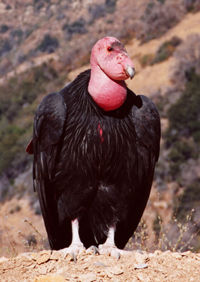Condor
 From Conservapedia
From Conservapedia | Condor | |
|---|---|

| |
| California condor Gymnogyps californianus | |
| Scientific classification | |
| Kingdom Information | |
| Domain | Eukaryota |
| Kingdom | Animalia |
| Subkingdom | Bilateria |
| Phylum Information | |
| Phylum | Chordata |
| Sub-phylum | Vertebrata |
| Infraphylum | Gnathostomata |
| Class Information | |
| Superclass | Tetrapoda |
| Class | Aves |
| Sub-class | Neornithes |
| Order Information | |
| Order | Cathartiformes |
| Family Information | |
| Family | Cathartidae |
| Genus Information | |
| Genera | Gymnogyps Vultur |
| Species Information | |
| Binomial name | G. californianus V. gryphus |
| Population statistics | |
Condors are two species of vulture (family Cathartidae) found in the western United States and the Andean mountains and coastal areas of South America. They are among the largest living flying birds, each about 50 inches long with wingspans in excess of 10 feet.
Of the two, the Andean condor (Vultur gryphus) is the more common. It is all-black in color with gray upper wing secondaries, a bare gray head, and in males, a fleshy wattle crest. The species ranges from the Pacific coast to high up in the Andes, subsisting on carrion.
The California condor (Gymnogyps californianus) is slightly smaller, with white wing linings and a bare yellowish-orange head. The species formerly had an extensive range throughout the western United States, but habitat loss, slow breeding (one egg every two years) and overkill by man reduced it to 27 birds in the foothills and mountains north of Los Angeles, California by 1970. By the early 1980s with its numbers further reduced, all remaining wild condors were captured and put into a breeding program for eventual release back into the wild. By the 1990s the population had grown to 100, and many were released and monitored not only in California but in the Grand Canyon area of northern Arizona where they had not been seen in more than a century, and in Baja California where the last Mexican sighting took place in 1937.
Taxonomy[edit]
The word "condor" is a Spanish word which originated from the Quechua kuntur[1]. The Spanish conquistadors in the 16th century were probably the first Europeans to have seen a condor.
The scientific name of the Andean condor, Vultur gryphus, was coined by Carl Nilsson Linnæus in 1758[2]. The California condor was first described in 1797 by George Shaw under the name of Vultur californianus, and thus included in the immediate kinship with the Andean condor[3]. It was only in the nineteenth century that vultures were taxonomically more distinct, and the genus Gymnogyps was set up by the Frenchman René Lesson in 1842[4]. Both species today belong in each case to a monotypical genus (Vultur and Gymnogyps)[5]
DNA studies on the cytochrome B gene revealed that the Andean condor is more closely related to the three species of Cathartes (turkey vultures) than to the California condor, and the latter is closer to the black vulture (Coragyps atratus) than with the Andean condor[6]. The similarity of the two Condor species is thus due to convergence.
References[edit]
- ↑ https://www.merriam-webster.com/dictionary/condor
- ↑ Carolus Linnæus: Systema Naturæ, Stockholm 1758
- ↑ George Shaw, Frederick P. Nodder: The naturalist’s miscellany, or coloured figures of natural objects, 9th volume. London 1797, pg. 301
- ↑ René Lesson: Index ornithologique; L’Écho du Monde Savant. Ser. 2, Bd. 6, 1842, pp. 1035–1039
- ↑ The genus Vultur originally contained all vultures world-wide
- ↑ M. Wink: "Phylogeny of Old and New World vultures (Aves: Accipitridae and Cathartidae) inferred from nucleotide sequences of the mitochondrial cytochrome b gene". Journal of Natural Science, C. Bd. 50, Nr. 11–12, 1995, S. 868–882
Links[edit]
- Grand Canyon National Park site page on the condor
- Peregrine Fund on data of condors released in Arizona
- San Diego Zoo info on sighting a condor
- News brief on the condor's reappearance in San Diego
Categories: [Birds] [Birds of Prey] [Vultures] [North America] [South America]
↧ Download as ZWI file | Last modified: 03/11/2023 13:22:09 | 52 views
☰ Source: https://www.conservapedia.com/Condor | License: CC BY-SA 3.0
 ZWI signed:
ZWI signed: KSF
KSF